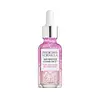What's inside
What's inside
 Key Ingredients
Key Ingredients

 Benefits
Benefits

 Concerns
Concerns

No concerns
 Ingredients Side-by-side
Ingredients Side-by-side

Water
Skin ConditioningButylene Glycol
HumectantGlycerin
HumectantNiacinamide
SmoothingPentylene Glycol
Skin ConditioningCeramide AP
Skin Conditioning1,2-Hexanediol
Skin ConditioningCarbomer
Emulsion StabilisingCaprylyl Glycol
EmollientCaesalpinia Spinosa Fruit Extract
Skin ProtectingPullulan
Chondrus Crispus Extract
Skin ConditioningPolysorbate 20
EmulsifyingDipotassium Glycyrrhizate
HumectantDisodium EDTA
Sodium Hydroxide
BufferingKappaphycus Alvarezii Extract
Skin ConditioningCollagen Amino Acids
MoisturisingIron Oxides
Leuconostoc/Radish Root Ferment Filtrate
AntimicrobialPhenoxyethanol
PreservativeTitanium Dioxide
Cosmetic ColorantAgar
MaskingCalcium Alginate
MaskingSodium Lactate
BufferingXanthan Gum
EmulsifyingHydroxyacetophenone
AntioxidantTropolone
Skin ConditioningGluconolactone
Skin ConditioningHydrolyzed Hyaluronic Acid
HumectantSodium Benzoate
MaskingSodium Hyaluronate
HumectantCI 73360
Cosmetic ColorantRetinyl Palmitate
Skin ConditioningPalmitoyl Tripeptide-1
Skin ConditioningPalmitoyl Tetrapeptide-7
Skin ConditioningWater, Butylene Glycol, Glycerin, Niacinamide, Pentylene Glycol, Ceramide AP, 1,2-Hexanediol, Carbomer, Caprylyl Glycol, Caesalpinia Spinosa Fruit Extract, Pullulan, Chondrus Crispus Extract, Polysorbate 20, Dipotassium Glycyrrhizate, Disodium EDTA, Sodium Hydroxide, Kappaphycus Alvarezii Extract, Collagen Amino Acids, Iron Oxides, Leuconostoc/Radish Root Ferment Filtrate, Phenoxyethanol, Titanium Dioxide, Agar, Calcium Alginate, Sodium Lactate, Xanthan Gum, Hydroxyacetophenone, Tropolone, Gluconolactone, Hydrolyzed Hyaluronic Acid, Sodium Benzoate, Sodium Hyaluronate, CI 73360, Retinyl Palmitate, Palmitoyl Tripeptide-1, Palmitoyl Tetrapeptide-7
Ingredients Explained
These ingredients are found in both products.
Ingredients higher up in an ingredient list are typically present in a larger amount.
Caprylyl Glycol is a humectant and emollient, meaning it attracts and preserves moisture.
It is a common ingredient in many products, especially those designed to hydrate skin. The primary benefits are retaining moisture, skin softening, and promoting a healthy skin barrier.
Though Caprylyl Glycol is an alcohol derived from fatty acids, it is not the kind that can dry out skin.
This ingredient is also used as a preservative to extend the life of products. It has slight antimicrobial properties.
Learn more about Caprylyl GlycolDisodium EDTA plays a role in making products more stable by aiding other preservatives.
It is a chelating agent, meaning it neutralizes metal ions that may be found in a product.
Disodium EDTA is a salt of edetic acid and is found to be safe in cosmetic ingredients.
Learn more about Disodium EDTAPhenoxyethanol is a preservative that has germicide, antimicrobial, and aromatic properties. Studies show that phenoxyethanol can prevent microbial growth. By itself, it has a scent that is similar to that of a rose.
It's often used in formulations along with Caprylyl Glycol to preserve the shelf life of products.
Polysorbate 20 is made by combining ethoxylation of sorbitan, ethylene oxide, and lauric acid. It is a mild cleansing agent, surfactant, and emulsifier.
As a surfactant, it helps collect dirt and oils for washing. Emulsifiers prevent oils and water from separating.
Polysorbate 20 also adds scent to a product. Since it is made using sorbitol, it has a sweet scent. Sorbitol can also be found in fruits such as apples and peaches.
The lauric acid used to create Polysorbate 20 is often derived from coconuts.
Polysorbate 20 may not be fungal acne safe.
Learn more about Polysorbate 20Sodium Hyaluronate is hyaluronic acid's salt form. It is commonly derived from the sodium salt of hyaluronic acid.
Like hyaluronic acid, it is great at holding water and acts as a humectant. This makes it a great skin hydrating ingredient.
Sodium Hyaluronate is naturally occurring in our bodies and is mostly found in eye fluid and joints.
These are some other common types of Hyaluronic Acid:
Learn more about Sodium HyaluronateWater. It's the most common cosmetic ingredient of all. You'll usually see it at the top of ingredient lists, meaning that it makes up the largest part of the product.
So why is it so popular? Water most often acts as a solvent - this means that it helps dissolve other ingredients into the formulation.
You'll also recognize water as that liquid we all need to stay alive. If you see this, drink a glass of water. Stay hydrated!
Learn more about WaterXanthan gum is used as a stabilizer and thickener within cosmetic products. It helps give products a sticky, thick feeling - preventing them from being too runny.
On the technical side of things, xanthan gum is a polysaccharide - a combination consisting of multiple sugar molecules bonded together.
Xanthan gum is a pretty common and great ingredient. It is a natural, non-toxic, non-irritating ingredient that is also commonly used in food products.
Learn more about Xanthan Gum